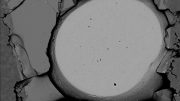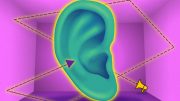
New research demonstrates how laser light can amplify the nonlinear optical properties of hexagonal boron nitride (hBN). The research successfully generated new optical frequencies and significantly increased third-harmonic generation, marking a significant advancement in the field of nonlinear optics and quantum material research.
A recent study published in Nature Communications reveals that engineers from Columbia University, in collaboration with theoretical experts at the Max Planck Institute for the Structure and Dynamics of Matter, have discovered that pairing laser light to crystal lattice vibrations can enhance the nonlinear optical properties of a layered 2D material.
Cecilia Chen, a Columbia Engineering PhD student and co-author of the recent paper, and her colleagues from Alexander Gaeta’s Quantum and Nonlinear Photonics group used hexagonal boron nitride (hBN). hBN is a 2D material similar to graphene: its atoms are arranged in a honey-combed-shaped repeating pattern and can be peeled into thin layers with unique quantum properties. Chen noted that hBN is stable at room temperature, and its constituent elements—boron and nitrogen—are very light. That means they vibrate very quickly.
Understanding Atomic Vibrations
Atomic vibrations occur in all materials above absolute zero. That movement can be quantized into quasiparticles called phonons with particular resonances; in hBN’s case, the team was interested in the optical phonon mode vibrating at 41 THz, corresponding to a wavelength of 7.3 μm, which is in the mid-infrared regime of the electromagnetic spectrum.
While mid-IR wavelengths are considered short, and thus, high energy, in the picture of crystal vibrations, they are considered very long and low energy in most optics research with lasers, where the overwhelming majority of experiments and studies are performed in the visible to near-IR range of approximately 400 nm to 2 um.
Experimentation and Results
When they tuned their laser system to hBN’s frequency corresponding to 7.3 μm, Chen, along with fellow PhD student Jared Ginsberg (now a data scientist at Bank of America) and postdoc Mehdi Jadidi (now a Team Lead at quantum computing company PsiQuantum), were able to coherently and simultaneously drive the phonons and electrons of the hBN crystal to efficiently generate new optical frequencies from the medium—an essential goal of nonlinear optics. Theoretical work led by Professor Angel Rubio’s group at Max Planck helped the experimental team understand their results.
Using commercially available, table-top mid-infrared lasers, they explored the phonon-mediated nonlinear optical process of four-wave mixing to generate light close to even harmonics of an optical signal. They also observed greater than a 30-fold increase in third-harmonic generation over what is achieved without exciting the phonons.
“We’re excited to show that amplifying the natural phonon motion with laser driving can enhance nonlinear optical effects and generate new frequencies,” said Chen. The team plans to explore how they might be able to modify hBN and materials like it using light in future work.
Reference: “Phonon-enhanced nonlinearities in hexagonal boron nitride” by Jared S. Ginsberg, M. Mehdi Jadidi, Jin Zhang, Cecilia Y. Chen, Nicolas Tancogne-Dejean, Sang Hoon Chae, Gauri N. Patwardhan, Lede Xian, Kenji Watanabe, Takashi Taniguchi, James Hone, Angel Rubio and Alexander L. Gaeta, 24 November 2023, Nature Communications.
DOI: 10.1038/s41467-023-43501-x
The study was funded by the US Department of Energy, the European Research Council, and the Deutsche Forschungsgemeinschaft.









Please think carefully:
1. What is the mechanism of light formation?
2. How does light propagate?
3. Does the medium disturb the motion of light?
4. Does your measurement method cause disturbance to light?
5. Is the medium that you cannot measure non-existent?
6. Where does the power of light movement come from?
and so on.
If researchers are truly interested in optics and physics. You can try browsing https://zhuanlan.zhihu.com/p/569722770.
Science must follow mathematical rules. For example, the Standard Model (SM) is considered to be one of the most significant achievements of physics in the 20th century. However, the magnetic moment of μ particle is larger than expected, revealed by a g-2 experiment at Fermilab, suggests that the established theory (such as SM) of fundamental particles is incomplete. Furthermore, the SM omitting gravity, it not involved the time problem and when the particle movement starts. Mathematics is the foundation of science. Physics must respect the scientific nature of mathematics and mathematical models. The SM must be based on mathematical models in order to be scientific, convincing, and in line with natural laws.
I hope researchers are not fooled by the pseudoscientific theories of the Physical Review Letters (PRL), and hope more people dare to stand up and fight against rampant pseudoscience.
The so-called academic journals (such as Physical Review Letters, Nature, Science, etc.) firmly believe that two high-dimensional spacetime objects (such as two sets of cobalt-60) rotating in opposite directions can be transformed into two objects that mirror each other, is a typical case of pseudoscience rampant.
If researchers are really interested in Science and Physics, you can browse https://zhuanlan.zhihu.com/p/643404671 and https://zhuanlan.zhihu.com/p/595280873.